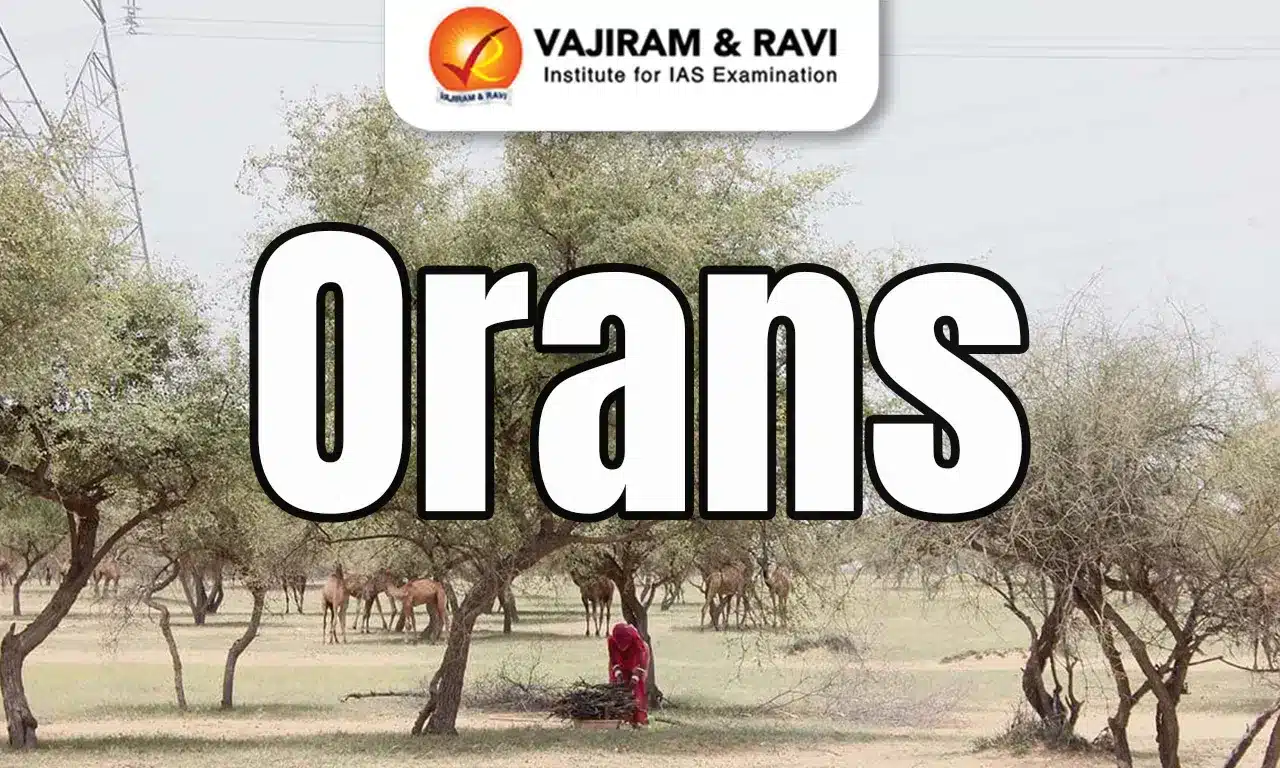Orans Latest News
Rajasthan has initiated the process for classifying the community-protected ‘Oran’ lands as forests in compliance with the Supreme Court’s direction.
About Orans
- Orans are traditional sacred groves found in Rajasthan.
- They are patches of forests dedicated by villagers to different deities as a socio-religious tradition and managed by the rural communities.
- Orans serve as centers of socio-religious activity for local communities. Festivals and fairs are held annually, often on specific dates, to honor these sacred places.
- Rajasthan is home to about 25,000 ‘Oran’ lands covering an area of 6 lakh hectares.
- ‘Oran’ land is used by local communities for grazing, forest products, natural water filtration, and for livelihood opportunities to promote the livestock economy.
- Water bodies within the orans, such as Talab (pond), Nadi (small pond), open wells, and streams, are crucial water resources for livestock and wildlife.
- In the Thar Desert, some orans have ancient goverdhan/shilalekh (petrograph) near water bodies.
- The area covered by an oran can range from a few hectares to several hundred hectares. For example, the Bhadariya Mata Oran in Jaisalmer district spans 17,821 hectares.
- Orans also form the natural habitat for India’s most critically endangered bird, the Great Indian Bustard (GIB), a protected species under the Wildlife Protection Act, which is also the State bird of Rajasthan.
- The State’s forest policy of 2023 gave the status of general community land to ‘Orans’, which was considered insufficient for their conservation as well as protection against encroachment and degradation.
- The Supreme Court recognised ‘Oran’ lands as forests under the Forest Conservation Act, 1980, in a landmark judgment delivered on December 18, 2024.
Orans FAQs
Q1. What are Orans?
Ans. Orans are traditional sacred groves found in Rajasthan.
Q2. Which critically endangered bird species is naturally protected in the Orans?
Ans. Great Indian Bustard
Q3. Approximately how many Oran lands exist in Rajasthan?
Ans. 25,000
Source: TH
Last updated on November, 2025
→ Check out the latest UPSC Syllabus 2026 here.
→ Join Vajiram & Ravi’s Interview Guidance Programme for expert help to crack your final UPSC stage.
→ UPSC Mains Result 2025 is now out.
→ UPSC Notification 2026 is scheduled to be released on January 14, 2026.
→ UPSC Calendar 2026 is released on 15th May, 2025.
→ The UPSC Vacancy 2025 were released 1129, out of which 979 were for UPSC CSE and remaining 150 are for UPSC IFoS.
→ UPSC Prelims 2026 will be conducted on 24th May, 2026 & UPSC Mains 2026 will be conducted on 21st August 2026.
→ The UPSC Selection Process is of 3 stages-Prelims, Mains and Interview.
→ UPSC Result 2024 is released with latest UPSC Marksheet 2024. Check Now!
→ UPSC Prelims Result 2025 is out now for the CSE held on 25 May 2025.
→ UPSC Toppers List 2024 is released now. Shakti Dubey is UPSC AIR 1 2024 Topper.
→ UPSC Prelims Question Paper 2025 and Unofficial Prelims Answer Key 2025 are available now.
→ UPSC Mains Question Paper 2025 is out for Essay, GS 1, 2, 3 & GS 4.
→ UPSC Mains Indian Language Question Paper 2025 is now out.
→ UPSC Mains Optional Question Paper 2025 is now out.
→ Also check Best IAS Coaching in Delhi

















